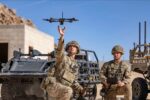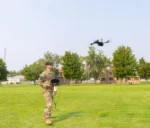At DSEI 2025 in London, a new short-range air defense (SHORAD) variant of the British Army’s Foxhound light protected patrol vehicle was unveiled. Designed to counter low-altitude threats including drones and rotary-wing aircraft, the system features a modular architecture capable of integrating multiple weapon types—ranging from autocannons to missiles—on a compact and mobile platform.
Foxhound Platform Adapted for SHORAD Roles
The base platform is the General Dynamics Land Systems–UK (GDLS-UK) Foxhound LPPV (Light Protected Patrol Vehicle), originally introduced in 2012 as an agile mine-resistant vehicle for urban and patrol operations. The SHORAD variant retains the core blast-resistant V-shaped hull but replaces its standard crew compartment with a modular turret ring capable of supporting various remote weapon stations (RWS).
The showcased configuration at DSEI included Rheinmetall’s Skyranger 30 turret—a compact air defense module armed with a 30×173 mm revolver cannon and advanced tracking sensors. The Skyranger system is optimized for engaging Group 1–3 UAS targets (under 600 kg), loitering munitions, and helicopters at ranges up to ~3 km. Its fire control suite includes electro-optical/infrared (EO/IR) sensors and radar integration options.
Modular Weapon Options Expand Mission Flexibility
A key feature of the Foxhound SHORAD concept is modularity. The platform can host different RWS modules depending on mission requirements:
- Rheinmetall Skyranger 30: Autocannon-based solution with programmable airburst munitions.
- MBDA Mistral ATLAS-RC: Remote-controlled twin missile launcher using infrared-guided Mistral missiles (~6 km range).
- Thales RapidFire or CTA40-based turrets: Potential future integrations offering higher caliber or multi-role engagement.
This flexibility allows forces to tailor their SHORAD assets for specific threat environments—urban drone swarms vs open-area rotary-wing threats—without changing the base vehicle fleet.
C-UAS Emphasis Reflects Evolving Threat Landscape
The integration of counter-unmanned aerial systems (C-UAS) capabilities into tactical ground vehicles reflects NATO-wide concern over proliferating drone threats. Lessons from Ukraine have demonstrated how even small quadcopters can be used for ISR or strike roles at battalion level. A lightweight SHORAD solution like the Foxhound variant offers maneuver units organic protection against such threats without relying solely on centralized IADS coverage.
The Skyranger’s programmable airburst rounds are particularly suited to defeating Class I drones that are difficult to hit with conventional point-detonation rounds. Additionally, Rheinmetall has indicated that future iterations could integrate soft-kill options such as RF jamming or directed energy modules on similar platforms.
Sensors and Network Integration
The effectiveness of mobile SHORAD depends heavily on sensor fusion and networked targeting. While the DSEI demonstrator did not display full sensor integration details, Rheinmetall confirmed that the Skyranger turret supports cueing from external radar sources via standard NATO datalinks such as Link-16 or national equivalents.
This enables “sensor-to-shooter” workflows where higher-echelon surveillance radars detect incoming threats while forward-deployed vehicles like Foxhound-SHORAD execute rapid engagements based on shared targeting data. Such integration aligns with broader C4ISR modernization efforts across NATO armies under programs like Land ISTAR or UK’s LE TacCIS initiative.
Operational Role in British Army Force Structure
No formal procurement has yet been announced by the UK Ministry of Defence (MoD), but industry sources suggest this concept could fill a capability gap in short-range air defense for light brigades or expeditionary forces. The British Army currently lacks an integrated mobile C-UAS/SHORAD system organic to its light forces; Rapier was retired in 2021 without direct replacement at tactical echelons.
If adopted, the Foxhound-SHORAD could complement heavier platforms like Sky Sabre by providing close-in protection during maneuver operations or in forward operating bases (FOBs). Its high mobility (~110 km/h top speed) and small logistics footprint make it suitable for rapid deployment missions where larger systems are impractical.
Industry Outlook and Export Potential
The unveiling at DSEI appears aimed not only at domestic stakeholders but also export markets seeking affordable mobile C-UAS solutions. With growing interest from Eastern European nations following lessons from Ukraine—and tightening defense budgets—the ability to retrofit existing protected mobility fleets with modular SHORAD kits may prove attractive.
Rheinmetall has already marketed Skyranger variants on Boxer 8x8s; adapting it to lighter platforms like Foxhound demonstrates scalability across force structures. MBDA’s ATLAS-RC also enjoys export traction due to its low weight (~300 kg) and proven missile system lineage.
Conclusion
The Foxhound SHORAD concept presented at DSEI 2025 represents an evolution toward distributed air defense tailored for modern drone-era battlefields. By leveraging modular weapons architecture on a proven light protected chassis, it offers potential solutions for both national forces facing emerging aerial threats and allied partners seeking cost-effective mobile defenses. Whether this remains a technology demonstrator or enters service will depend on doctrinal alignment—and funding decisions—in coming months.









